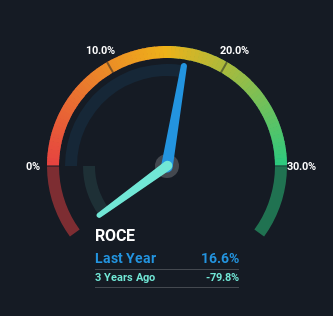Returns On Capital Are Showing Encouraging Signs At TAS Offshore Berhad (KLSE:TAS)

Did you know there are some financial metrics that can provide clues of a potential multi-bagger? Ideally, a business will show two trends; firstly a growing return on capital employed (ROCE) and secondly, an increasing amount of capital employed. If you see this, it typically means it's a company with a great business model and plenty of profitable reinvestment opportunities. Speaking of which, we noticed some great changes in TAS Offshore Berhad's (KLSE:TAS) returns on capital, so let's have a look.
Return On Capital Employed (ROCE): What Is It?
Just to clarify if you're unsure, ROCE is a metric for evaluating how much pre-tax income (in percentage terms) a company earns on the capital invested in its business. Analysts use this formula to calculate it for TAS Offshore Berhad:
Return on Capital Employed = Earnings Before Interest and Tax (EBIT) ÷ (Total Assets - Current Liabilities)
0.17 = RM16m ÷ (RM164m - RM65m) (Based on the trailing twelve months to August 2023).
So, TAS Offshore Berhad has an ROCE of 17%. On its own, that's a standard return, however it's much better than the 8.2% generated by the Machinery industry.
See our latest analysis for TAS Offshore Berhad

In the above chart we have measured TAS Offshore Berhad's prior ROCE against its prior performance, but the future is arguably more important. If you're interested, you can view the analysts predictions in our free report on analyst forecasts for the company.
What The Trend Of ROCE Can Tell Us
You'd find it hard not to be impressed with the ROCE trend at TAS Offshore Berhad. We found that the returns on capital employed over the last five years have risen by 852%. That's not bad because this tells for every dollar invested (capital employed), the company is increasing the amount earned from that dollar. Interestingly, the business may be becoming more efficient because it's applying 39% less capital than it was five years ago. A business that's shrinking its asset base like this isn't usually typical of a soon to be multi-bagger company.
One more thing to note, TAS Offshore Berhad has decreased current liabilities to 40% of total assets over this period, which effectively reduces the amount of funding from suppliers or short-term creditors. So shareholders would be pleased that the growth in returns has mostly come from underlying business performance.
What We Can Learn From TAS Offshore Berhad's ROCE
From what we've seen above, TAS Offshore Berhad has managed to increase it's returns on capital all the while reducing it's capital base. And with the stock having performed exceptionally well over the last five years, these patterns are being accounted for by investors. Therefore, we think it would be worth your time to check if these trends are going to continue.
If you'd like to know more about TAS Offshore Berhad, we've spotted 5 warning signs, and 2 of them can't be ignored.
For those who like to invest in solid companies, check out this free list of companies with solid balance sheets and high returns on equity.
Valuation is complex, but we're here to simplify it.
Discover if TAS Offshore Berhad might be undervalued or overvalued with our detailed analysis, featuring fair value estimates, potential risks, dividends, insider trades, and its financial condition.
Access Free AnalysisHave feedback on this article? Concerned about the content? Get in touch with us directly. Alternatively, email editorial-team (at) simplywallst.com.
This article by Simply Wall St is general in nature. We provide commentary based on historical data and analyst forecasts only using an unbiased methodology and our articles are not intended to be financial advice. It does not constitute a recommendation to buy or sell any stock, and does not take account of your objectives, or your financial situation. We aim to bring you long-term focused analysis driven by fundamental data. Note that our analysis may not factor in the latest price-sensitive company announcements or qualitative material. Simply Wall St has no position in any stocks mentioned.
About KLSE:TAS
TAS Offshore Berhad
An investment holding company, engages in the shipbuilding and ship repairing activities in Malaysia, Singapore, and Indonesia.
Flawless balance sheet and good value.
Market Insights
Community Narratives



